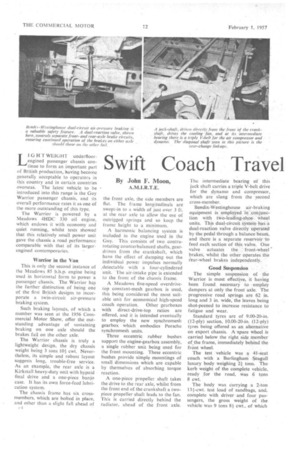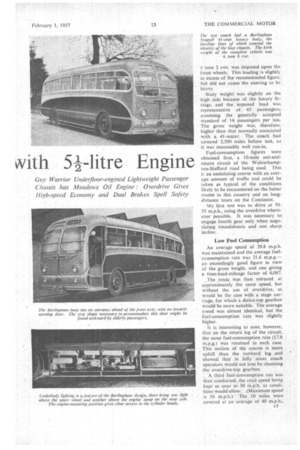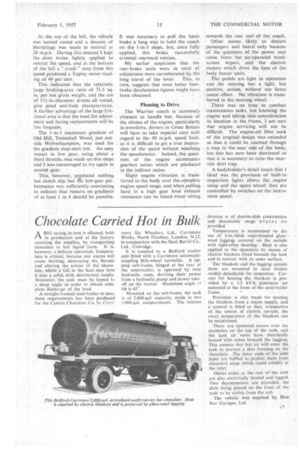Swift Coach• Travel
Page 42

Page 43

Page 44

Page 45

If you've noticed an error in this article please click here to report it so we can fix it.
By John F. Moon, A.M.I.R.T.E.
LI G H T WEIGHT underfloor • engined passenger chassis con . tinue to form an important part of British production, having become generally acceptable to operators in this country and in certain countries overseas. The latest vehicle to be introduced into this range is the Guy Warrior passenger chassis, and its overall performance rates it as one of the more outstanding of this type.
The Warrior is powered by a Meadows 4HDC 330 oil engine, which endows it with economy and quiet running,, whilst tests showed that this relatively small power unit gave the chassis a road performance comparable with that of its largerengined contemporaries.
Warrior in the Van
This is only the second instance of the Meadows 85 b.h.p. engine being used in horizontal form to power a passenger chassis. The Warrior has the further distinction of being one of the first British designs to incorporate a twin-circuit air-pressure braking system.
Such braking layouts, of which a number was seen at the 1956 Commercial Motor Show, offer the outstanding advantage of sustaining braking on one axle should the brakes fail on the other axle.
The Warrior chassis is truly a lightweight design, the dry chassis weight being 3 tons 10-4 cwt. Nevertheless, its simple and robust layout suggests long, trouble-free service. As an example, the rear axle is a Kirkstall heavy-duty unit with hypoid final drive and a one-piece banjo case. It has its own force-feed lubrication system.
The chassis frame has six crossmembers, which are bolted in place, and other than a slight fall ahead of thefront axle, the side members are flat. The frame longitudinals are swept-in to a width of just over 3 ft. at the rear axle to allow the use of outrigged springs and so keep the frame height to a minimum, A harmonic balancing system is included in the engine used in the Guy. This consists of two contrarotating counterbalanced shafts, geardriven from the crankshaft, which have the effect of damping out the individual power impulses normally .detectable with a four-cylindered unit. The air-intake pipe is extended to the front of the chassis frame.
A Meadows five-speed overdrivetop constant-mesh gearbox is used, this being considered the most suitable unit for economical high-speed coach operation, Other gearboxes with direct-drive-top ratios are offered, and it is intended eventually to employ the new synchromesh gearbox which embodies Porsche synchromesh units.
Three eccentric rubber bushes support the engine-gearbox assembly, a single rubber unit being used for the front mounting. These eccentric bushes provide simple mountings of small dimensions which are capable by themselves of absorbing torque reaction.
A one-piece propeller shaft takes the drive to the rear axle, whilst from the front end of the crankshaft a twopiece propeller shaft leads to the fan. This is carried directly behind the radiator, ahead of the front axle. The intermediate bearing of this jack shaft carries a triple V-belt drive for the dynamo and compressor, which are slung from the second cross-member.
Bendix-Westinghouse air-braking equipment is employed in' conjunction with tWo-leading-shoe wheel units. This dual-circuit system has-a dual-reaction valve directly operated by the pedal through a balance beam, and there is a separate reservoir -,to feed each section of this valve. One valve actuates the front-wheel° brakes, whilst the other operates the rear-wheel brakes independently.
Good Suspension
The simple suspension of the Warrior is most effective, it having been found necessary to employ dampers at only the front axle. The progressive road springs are 62 in. long.and 3 in. wide, the leaves being shot-peened to increase resistance to fatigue and wear.
Standard tyres are of 9.00-20-in. (12-ply) section. 10.00-20-in. (12-ply) tyres being offered as an alternative on export chassis. A -spare wheel is carried below the right side member of the frame, immediately behind the front wheel.
The test vehicle was a 41-seat coach with a Burlingham Seagull luxury body weighing 24 tons. The kerb weight of the complete vehicle, ready for the road, was 6 tons 8 cwt.
The body was carrying a 2-ton 131-cwt. test load of sandbags, and, complete with driver and four passengers, the gross weight of the vehicle was 9 tons 84 cwt., of which
4 tons 2 cwt. was imposed upon tha front wheels. This loading is slightly in excess of the recommended figure, but did not cause the steering to be heavy.
Body weight was slightly on the high side because of the luxury fittings, and the imposed load was representative of 45 passengers, assuming the generally accepted standard of 16 passengers per ton. The gross weight was, therefore, higher than that normally associated with a 41 -seater. The coach had covered 2,500 miles before test, so it was reasonably well run-in.
Fuel-consumption figures were obtained first, a 10-mile out-andreturn circuit of the Wolverhampton-Stafford road being used. This is an undulating course with an average amount of traffic and could be taken as typical of the conditions likely to be encountered on the better routes in this country and on longdistance tours on the Continent.
Vly first test was to drive at 3035 m.p.h., using the overdrive whereever possible. It was necessary to engage fourth gear only when negotiating roundabouts and one sharp incline.
Low Fuel Consumption
An average speed of 29.8 m.p.h. was maintained and the average fuelconsumption rate was 21.6 m.p.g.an exceedingly good figure in view of the gross weight, and one giving a time-load-mileage factor of 6,067.
The route was then retraced at approximately the same speed, but without the use of overdrive, as would be the case with a stage carriage, for which a direct-top gearbox • would be more suitable. The average seed was almost identical, but the fuel-consumption rate was slightly higher.
It is interesting to note, however, that on the return leg of the circuit, the same fuel-consumption rate (17.8 m.p.g.) was returned in each case. This section of the course is more uphill than the outward leg and showed that in hilly areas coach operators Would not lose by choosing the overdrive-top gearbox.
A third fuel-consumption run was then conducted, the road speed being kept as near to 50 m.p.h. as conditions would allow. (Maximum speed is 56 m.p.h.) The 10 miles were covered at an average of 40 m.p.h., whilst the fuel-consumption rate went up to 17.6 m.p.g. This test resulted in a time-load-mileage factor of 6,636, which is the second highest ever recorded for a passenger vehicle.
The fuel-consumption results obtained during these three tests show the advantage to be gained from the use of a small, highefficiency oil engine on fast longdistance work, and still maintained when operating at half maximum speed. Although small, the Meadows engine has large bearing surfaces and its construction is simple, so it cannot necessarily be assumed that its life would be any shorter than that of a larger engine working under similar conditions.
Braking tests produced some excel
lent figures. When making emerr6
gcncy stops from 20 m.p.h., the average deceleration rates shown by the stopping distances and the maximum deceleration recorded by the Tapley meter were identical, which indicated a negligible lag in the air-pressure system. This lag was of the order of only 6 per cent, when braking from 30 m.p.h., and the result was that the coach was able to stop quickly but smoothly without the uneven braking characteristics which can cause passenger discomfort.
Unfortunately, the hand-brake performance was a little disappointing, for the maximum deceleration which could be obtained from 20 m.p.h. was only /6.5 per cent. This was with a laden coach, however, and the normal requirement is 30 per cent. with an unladen vehicle, so the
Warrior should be well up to the required standard.
Hermitage Hill, firidgnorth, was used for the engine-power and brakefade tests. This hill has an average gradient of 1 in 1.2, with a section approaching 1 in 7, and is approximately three-quarters of a mile long.
A clean second-gear climb was made in three minutes in an ambient temperature of 49° F. and the enginewater temperature rose during the climb from 155° F. to 163° F. (at which the thermostat opens).
Good hill-climbing performance was allied to adequate cooling, and although a closer:ratio gearbox would be preferable for continuous operation in hilly areas, the coach with the overdrive gearbox can operate successfully in such areas. At the top of the hill, the vehicle was turned round and a descent of Hermitage was made in neutral at 20 m.p.h. During this descent I kept the ...foot brake lightly applied to restrict the speed, and at the bottom of the hill a "crash " stop from this speed produced a Tapley meter reading of 49 per cent.
This indicated, that the relatively large braking-area ratio of 71.5 'sq. in. per ton gross weight, and the use of 151-in.-diameter drums all .round, give good anti-fade characteristics. A further advantage of the large frictional area is that the need for adjustment and facing replacements will be less frequent.
The 1-in-5 maximum gradient of Old Hill, Tettenhall Wood, just outside Wolverhampton, was used for the gradient stop-start test. An easy restart in low gear, using about a third throttle, was made on this slope and I was.encouraged to try again in second gear.
This, however, produced nothing but clutch slip, but tge low-gear performance was sufficiently convincing to indicate that restarts on gradients of at least 1 in 4 should be possible.
It was necessary to pull the harm brake a long way to hold the coach on the l-in-5 slope, but, once fug)/ applied, this brake successfully arrested rearward motion.
My earlier suspicions that the rear-brake units were in need of adjustment were corroborated by the long travel of the lever. This in turn, suggests that even better footbrake deceleration figures might have been obtained.
Pteasing to Drive The Warrior coach is extremely pleasant to handle but, because of the silence of the engine, particularly in overdrive, drivers in Great Britain will have to take especial care with regard to the 30 m.p.h. speed limit. as it is difficult to get a true impression of the speed without watching the speedometer. Indeed, the quietness of the engine accentuates gearbox noises which are produced in the indirect ratios.
Slight engine vibration is transferred to the body over the-complete engine speed range, and when pulling hard in a high gear loud exhaust resonance can be heard when sitting
towards the rear end of the coach.
Other noises likely to disturb passengers and heard only because of the quietness of the power unit come from the air-operated windscreen wipers, and the electric motors which drive the fans of the body heater -units.
The pedals are light in operation and the steering has a light, but positive, action, without too fierce castor effect. No vibration is transferred to the steering wheel.
There was no time to conduct maintenance tasks, but knowing the engine and taking into consideration its location in the frame, I am sure that engine servicing will not be difficult. The engine-oil filler neck of the original design was extended so that it could be reached through a trap in the near side of the body, but this has now been shortened• so that it is necessary to raise the nearside skirt trap.
A bodybuilder's detail touch that 1 liked was the provision of built-in inspection lights above the engine sump and the spare wheel: they are controlled by switches on the instrument panel.




































































































